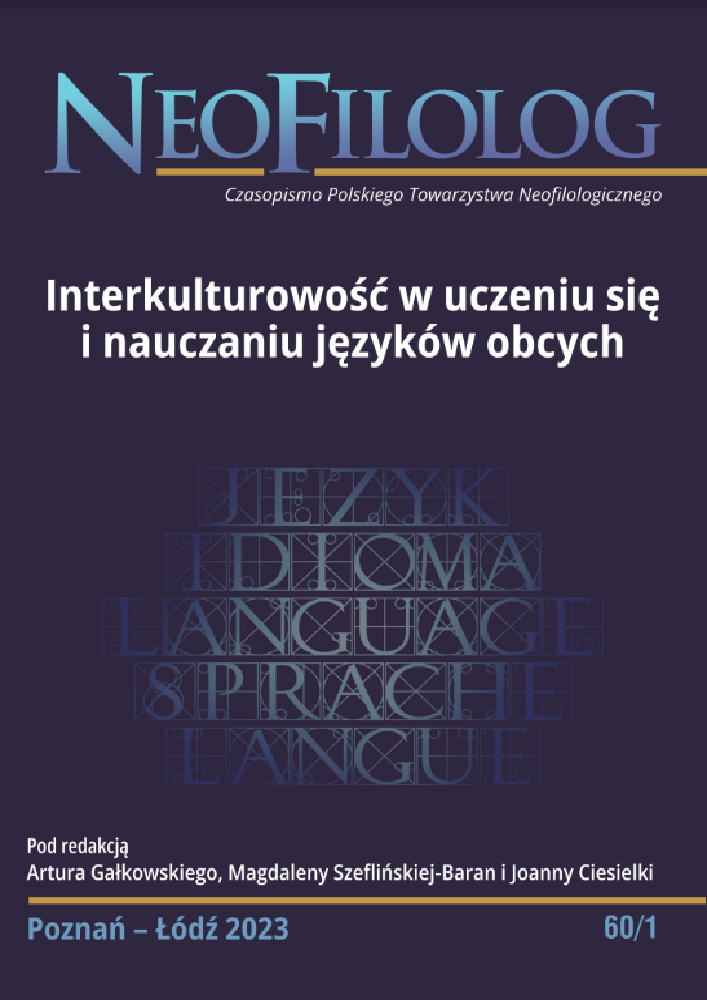Abstract
Didactic translations and translation projects are one of the ways of familiarising students simultaneously with a foreign language and culture, allowing them to develop language competences and learn about cultural similarities and differences. The aim of this article is to present a way of acquainting students with elements of foreign culture through translation, show the benefits of working with translation for language learning and present difficulties related to the translation of cultural elements and solutions used by translators. Teaching language and culture through translation has many advantages. First of all, working with the original text gives students access to the elements of the source culture in a specific communication context. Moreover, the translation assumes an in-depth understanding of the original, including intercultural allusions and intertextual references. The effort put into the translation process by the students makes them better memorize foreign elements and structures.
References
Andresen de Mello Breyner S. (1996), Contos exemplares. Porto: Figueirinhas.
Andresen de Mello Breyner S. (2018), Opowiadania przykładne. Lublin: Wydawnictwo UMCS.
Banach B. (2001), Interkulturowa tendencja we współczesnej glottodydaktyce, (w:) Habrajska G. (red.), Język w komunikacji. t.3. Łódź: Wydawnictwo Wyższej Szkoły Humanistyczno-Ekonomicznej, s. 228–242.
Bennett M. (1998), Intercultural Communication: A Current Perspective, (w:) Bennett M. (red.), Basic Concepts of Intercultural Communication. Yarmouth: Intercultural Press, s. 1–34. DOI: https://doi.org/10.1002/9781118783665.ieicc0178
Berman A. (2009), Przekład jako doświadczenie obcego, (w:) Bukowski P., Heydel M. (red.), Współczesne teorie przekładu. Kraków: Znak, s. 249–264.
Byram M. (1997), Teaching and Assessing Intercultural Communicative Competence. Clevedon: Multilingual Matters.
Dunin-Dudkowska A. (2011), Tłumaczenia dydaktyczne w nauce języka polskiego jako obcego. „Acta Universitatis Lodziensis. Kształcenie Polonistyczne Cudzoziemców”, nr 18, s. 387–392.
Giczela-Pastwa J., Biel Ł. (2021), Kooperacyjne uczenie się przekładu – 15 lat działalności Studenckiego Koła Naukowego Przekładu Specjalistycznego LINGUANA, (w:) Kubińska O., Kuniński W., Kur M. (red.), Dydaktyka przekładu. Nauczanie przez projekty. Gdańsk: Wydawnictwo Uniwersytetu Gdańskiego, s. 79–98.
Grucza F. (1979), Metody, techniki i ćwiczenia glottodydaktyczne, (w:) Grucza F. (red.), Polska myśl glottodydaktyczna 1945-1975. Wybór artykułów z zakresu glottodydaktyki ogólnej. Warszawa: PWN, s. 314–326.
Hinc J., Jarosz A. (2019), Tłumaczenia dydaktyczne w nauczaniu języka obcego – przykłady ćwiczeń na zdania warunkowe, (w:) Grabowska M., Hinc J., Jarosz A., Mampe J. (red.), Translatoryka i glottodydaktyka. Od teorii do praktyki. Gdańsk: Wydawnictwo Uniwersytetu Gdańskiego, s. 201–214.
Janowska I. (2015), Kompetencja komunikacyjna a glottodydaktyka, „LingVaria”, nr. 2, s. 41–54. DOI: https://doi.org/10.12797/LV.10.2015.20.04
Komorowska, H. (1996). Nowe tendencje w pracach programowych Rady Europy. Koncepcja celów nauczania języków obcych, „Języki Obce w Szkole”, nr 2, s. 109–115.
Komorowska H. (1999), Metodyka nauczania języków obcych. Warszawa: WSiP.
Lefevere A. (1992), Translation, Rewriting and the Manipulation of Literary Fame. Londyn i Nowy Jork: Routledge.
Lewicki R. (2002), Obcość w przekładzie a obcość w kulturze, (w:) Lewicki R. (red.), Przekład. Język. Kultura. Lublin: UMCS, s. 43–51.
Lipińska E., Seretny A. (2016), Tłumaczenie w nauczaniu/uczeniu się języka obcego – od słowa do tekstu, (w:) Lipińska E., Seretny A. (red.), Tłumaczenie dydaktyczne w nowoczesnym kształceniu językowym. Kraków: Księgarnia Akademicka, s. 23–35.
Nagórko A. (2004), Metody konfrontatywne a etnolingwistyka (lingwistyka kulturowa), (w:) Flórián E. (red.), Wielokulturowość, tożsamość narodowa, mniejszości na Węgrzech i w Polsce: język, literatura, kultura. Debreczyn: Kossuth Egyetemi K., s. 25-33.
Newmark P. (1988), Approaches to Translation. Hertfordshire: Prentice Hall.
Tomaszkiewicz T. (2006), Terminologia tłumaczenia. Poznań: UAM.
Toury G. (2000), The nature and role of norms in translation, (w:) Venuti L. (red.), The Translation Studies Reader. Londyn i Nowy York: Routledge, s. 199–211.
Venuti L. (2009), Przekład, wspólnota, utopia, (w:) P. Bukowski, M. Heydel (red.), Współczesne teorie przekładu. Kraków: Wydawnictwo Znak, s. 267–293.
Żydek-Bednarczuk U. (2012), Kompetencja międzykulturowa w nauczaniu języka polskiego jako obcego. „Postscriptum Polonistyczne”, nr 2 (10), s. 19–30.
License
Copyright (c) 2023 Agnieszka Kruk

This work is licensed under a Creative Commons Attribution-NoDerivatives 4.0 International License.
Authors
Authors of texts accepted for publication in Neofilolog are required to complete, sign and return to the Editorial team’s office the Agreement for granting a royalty-free license to works with a commitment to grant a CC sub-license.
Under the agreement, the authors of the texts published in Neofilolog grant Adam Mickiewicz University in Poznań a non-exclusive, royalty-free license and authorize the use of Attribution-NoDerivatives 4.0 International (CC BY-ND 4.0) Creative Commons sub-license.
The authors retain the right to the free disposal of the work.
Users
Interested Internet users are entitled to use works that have been published in Neofilolog since 2017, under the following conditions:
▪ attribution – obligation to provide, together with the distributed work, information about the authorship, title, source (link to the original work, DOI) and the license itself.
▪ no derivatives – the work must be preserved in its original form. Without the author's consent, it is not possible to distribute the modified work in the form of translations, publications, etc.
Copyrights are reserved for all texts published since 2017.
Miscellaneous
Adam Mickiewicz University in Poznań retains the property right as a whole (layout, graphic form, title, cover design, logo etc.).

